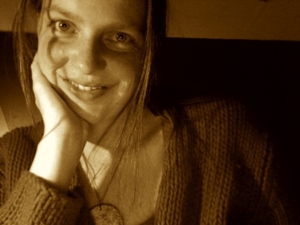Writing as Triathlon
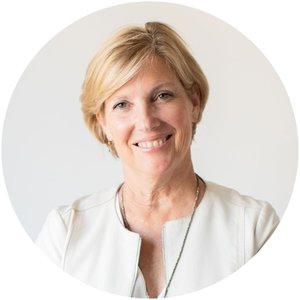 When I first began writing, I believed the most difficult part would be finishing a full-length manuscript, so I only thought it was important to take classes relating to story craft. It was a rude awakening to realize there was so much more I needed to know if anyone was ever going to be able to buy my book and read it.
When I first began writing, I believed the most difficult part would be finishing a full-length manuscript, so I only thought it was important to take classes relating to story craft. It was a rude awakening to realize there was so much more I needed to know if anyone was ever going to be able to buy my book and read it.
In a 2002 NY Times article, Think You Have a Book in You? Think Again, author Joseph Epstein cited a study that revealed “81% of Americans feel they have a book in them.” He goes on to use the rest of his essay to dissuade people from writing and suggests instead, “Keep it inside you where it belongs.”
Apparently, a lot of people do as Epstein suggests and “save the typing, save the trees.” On Reedsy.com, a blog states .01% ever make it to their goal of finishing that book. No doubt that is because a crafting great story is only about 30% of the book problem. Once authors type “The End,” it’s only the beginning of a long process to write query letters, secure an agent, sign a book contract and market the book. Add on to that the frustrating demand from publishers that writers must also build a “platform” on social media to sell their work, and really, it does seem like Epstein might have been right.
At the same time, it has never been easier for authors to bypass the agents who are gatekeepers of the Big Five publishing world and create their own books. The idea of “self-publishing” is not new, dating back to 1439 when the first printing press was invented by a German goldsmith named Johannes Gutenberg. Fast forward to 1979, when computers made desktop publishing accessible and the current print-on-demand technology possible.
In the last forty years, Amazon (KDP Direct) and Ingram (IngramSpark) have dominated and consolidated the POD world, creating a level of sophistication that can make a self-published book indistinguishable from traditionally published titles. But to navigate this part of the publishing universe, aspiring writers must learn how to turn their manuscripts into properly formatted files—a process which can seem daunting.
In truth, it simply takes more of the same persistence required to finish your 65,000-word manuscript. You can learn how to master plot lines and dialogue, as well as how to publish your own great book. Take, for example, the determination of Lisa Genova.
In 2007, she was simply a grad student who had received multiple rejections from traditional publishers. But Genova believed in her manuscript based on the story of her grandmother’s early onset Alzheimer’s, so the aspiring author self-published. After gaining popularity with readers, Simon & Shuster picked up the title and republished it two years later under the title Still Alice. Genova’s book, which had been initially rejected, was on The New York Times Best Seller List for more than 40 weeks, sold in 30 countries, translated into 20 languages, and became an Oscar-winning film. None of that would have happened if Genova had not taken the initiative to publish her own book.
In reality, writing a book is like completing a triathlon—and each of the three stages takes training: writing, publishing and marketing. Don’t wait until your last page to think about how to get your book in the world. Start now, learning to navigate the publishing and book-marketing world.
Maybe even more important than crafting your great characters is learning how your readers will ultimately discover them.
Learn About Self-publishing with Kathy
TUESDAY, OCTOBER 17, 2023: “Paths to Self-Publishing,” 6:00-8:00 p.m., in-person at Charlotte Lit
So, you’ve finished a manuscript and have made the decision to self-publish. Where do you start? Or, maybe you worry that self-publishing means “settling” for an unprofessional product. No matter on which side of that fence you sit, the volume of information and opinions is overwhelming. It can be difficult to know which services to trust and whether self-publishing is right for you. Kathy Izard has published four books three ways, including self-published and “Big Five.” Kathy will walk you through 10 steps to putting your words in the world. From purchasing your own ISBN number to ordering author copies, Kathy can answer all your questions about becoming a published author of adult or children’s books. Info
About Kathy
Kathy Izard is an award-winning author and speaker who writes inspirational nonfiction, including The Hundred Story Home, The Last Ordinary Hour and her upcoming release Trust the Whisper (Summer 2024). Kathy also publishes children’s books including A Good Night for Mr. Coleman and Grace Heard a Whisper (Fall 2023). Kathy has written essays for Katie Couric Media and her work as been featured on the Today Show, inspiring people to be changemakers in their community. Online: kathyizard.com.
The Challenge is the Gift
By Beth Murray
Irania Macias Reymann and I are collaborators, kindred creative spirits, and we’ve written two plays together.
In 2013, we wrote and toured a bilingual show with music for children called Mamá Goose. It was inspired by the beautiful Latino nursery rhyme anthology of the same title by Isabel Campoy and Alma Flor Ada. In that project we challenged ourselves to make a play engaging and relevant to young audience members across language and cultural borders. We used music, movement, English, Spanish, American Sign language, playful actors, and all the design elements of theatre to tell the story for a diverse audience.
Our second play, Tatas Tales: Los Cuentos de las Tatas, is also an adaptation of sorts. We created the play based on the writing, conversations, drawings, stories, and community of breast cancer survivors participating in Irania’s bibliotherapy groups—some Spanish-speaking, some English-speaking. At this moment, we have an English and a Spanish version of the same play written to a point where actors can read the piece for an audience, and seek a response.
Despite the vast age and topic differences, both projects bear similarities. Both involve navigating cultural and linguistic borderlands with story. Both projects involve adapting existing material that is not in a single-narrative form. Both projects began with one of us saying something like: “There’s this thing. It has possibilities to be a play. I have no idea how right now. Will you collaborate with me?” We always say “Sí.” And then we see.
The challenges are the gifts. The weaknesses are the strengths. The doubts are the possibilities. The community matters more than we do. So, yeah. It takes us a long time to create a play. The plays become of a place and of the people who shape them along the way. For Tatas Tales, there have been many people and places.
Program administrators who held space for creative breast cancer therapies.
Bold and brave writing group members.
Readers and performers of early drafts on Zoom.
Community programmers and librarians willing to open their doors to our reading events. Media folks.
Current cast members.
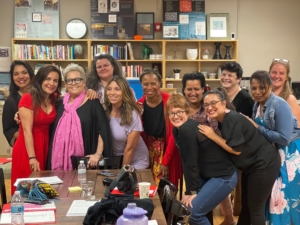 Irania and I are named as playwrights, but Tatas Tales/Los Cuentos de las Tatas reflects a plurality of authors, as the story is continually written and re-written in rehearsal and performance choices by the ensemble, even as the words stay constant. Our current cast includes five actors.
Irania and I are named as playwrights, but Tatas Tales/Los Cuentos de las Tatas reflects a plurality of authors, as the story is continually written and re-written in rehearsal and performance choices by the ensemble, even as the words stay constant. Our current cast includes five actors.
The photo shows 12 people (a 13th in spirit). Among those smiling faces are professional performers, novice performers, breast cancer survivors, witnesses to breast cancer, monolingual English speakers, emergent Spanish speakers, bilingual speakers with varying degrees of comfort and confidence with English and Spanish, fluent multilingual speakers, young professionals, middle-career professionals, and retirees. This patchwork of people will bring the script to life. The initial challenge of not having five bilingual actors available for all performance gave way to this richness.
The challenge, again, became the gift. It is a generous one.
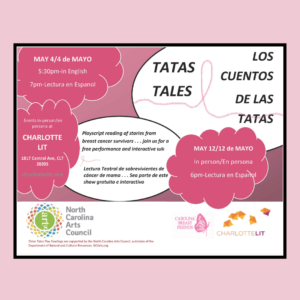 JOIN US for Tatas Tales/Los Cuentos de las Tatas:
JOIN US for Tatas Tales/Los Cuentos de las Tatas:
Wednesday, May 4: In-person in Charlotte Lit’s Studio Two, 5:30 p.m. in English – Register
Wednesday, May 4: In-person in Charlotte Lit’s Studio Two, 7:00 p.m. in Spanish – Registro
Thursday, May 12: Hybrid event, 6:00 p.m. in Spanish
• In-person in Charlotte Lit’s Studio Two – Registro
• Virtual through Charlotte Mecklenburg Library – Registro
NOTE: Proof of full Covid vaccination is required to attend in-person Charlotte Lit events. Send a picture of your vaccination card to staff@charlottelit.org. If you do not email it 24 hours before showtime, please be prepared to show proof of your vaccination at the door.
ABOUT IRANIA & BETH:
Irania Macias Patterson is an author and Certified Applied Poetry Therapy Facilitator (CAPF). For the past 22 years she has worked as an outreach program specialist for the Charlotte Mecklenburg Library. Her book Chipi Chipis, Small Shells of the Sea/Chipi Chipi Caracolitos del Mar, a winner of the 2006 International Reading Association Children’s Choice Award, Wings and Dreams: The Legend of Angel Falls. She also co-authored The Fragrance of Water, La Fragancia del Agua, and 27 Views of Charlotte. She is a 2020 recipient of an ASC grant assigned to write a poetry therapy play called Save the Tatas 2020. She holds a Master of Literature from La Universidad Autónoma de Barcelona, Spain, and a BA in Communication (UCAB) and Education (UNCC). She is also a trained teaching artist from Wolf Trap and The John F. Kennedy Center for the Performing Arts, and a Road Scholar for the North Carolina Humanity Council. She is the co- founder of Criss Cross Mangosauce, an edutainment company for families.
Beth Murray, Ph.D., has been a public-school theatre teacher, a freelance teaching artist, a program development facilitator, and a playwright/author/deviser for young audiences across her career. Beth’s current trajectories of creative activity and research explore, describe, question, and foster spaces where young people and those who teach and reach them put theatre and all the arts to work for learning and intercultural understanding. The Mamá Goose Project, in which Beth was co-playwright and director of a multilingual play for young audiences as well as a professional development facilitator and principal investigator, exemplifies her collaborative, multi-disciplinary approach. Cotton & Collards: Unearthing Stories of Home through Kitchens & Closets is a current inquiry with local and global artists, educators, and the Levine Museum of the New South. Dr. Murray has published in academic and practitioner journals, such as Youth Theatre Journal, English Teaching Forum and Middle School Journal and has contributed to books and anthologies. She is the current Director of Publications for International Drama and Education Association (IDEA) and an Associate Professor of Theatre Education at UNC Charlotte.
Make the Ordinary Sacred
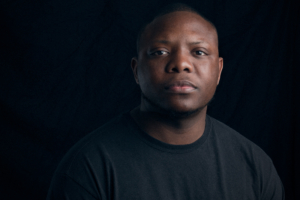 The past two years have been interesting, as we have entered into and through a pandemic, learned new skills, and discovered things about ourselves we may not have known were there. In the midst of that time, I have found myself reading poems, articles, and stories that speak to real life and emotions. The overwhelming number of things I’ve read that spoke to me were the courageous things. The poems about picking yourself out of bed when depression told you not to, reminiscing about eating a meal with your grandmother before she passed, and harnessing the joy of a child’s laugh to name a few. The elements that all these stories had in common was an elevation of the ordinary. They celebrated regular people cherishing the seemingly mundane but also recognizing the effort it takes to do so.
The past two years have been interesting, as we have entered into and through a pandemic, learned new skills, and discovered things about ourselves we may not have known were there. In the midst of that time, I have found myself reading poems, articles, and stories that speak to real life and emotions. The overwhelming number of things I’ve read that spoke to me were the courageous things. The poems about picking yourself out of bed when depression told you not to, reminiscing about eating a meal with your grandmother before she passed, and harnessing the joy of a child’s laugh to name a few. The elements that all these stories had in common was an elevation of the ordinary. They celebrated regular people cherishing the seemingly mundane but also recognizing the effort it takes to do so.
The poems that relish and elevate the small things are the ones that have the most impact. For example, Patricia Smith has a poem entitled “When the Burning Begins” where she details making cornbread with her father before he passed. While the act of making cornbread isn’t particularly exciting, the vibrant language, colorful storytelling, and active wordplay allows us to exist in the moment and have a greater appreciation for what that act represents.
When you are crafting your own work, take a look at the things around you. What is something that you do every day as a ritual? What does that look and feel like? What makes it something special to you? Asking yourself those questions can help you find and define a purpose in that routine. Perhaps you brush your teeth a certain way because your mother told you that when you were younger and now it’s also a way to honor her. Perhaps you eat a certain meal on a particular day because it reminds you of something. Take those ordinary occurrences and detail the process of what it takes to create it. There is always some beauty in the seemingly ordinary.
ABOUT ANGELO: Angelo ‘Eyeambic’ Geter is a dynamic poet, spoken word artist and motivational speaker who merges his passions for poetry and speaking into a unique performance that educates, entertains, and inspires. Over the course of his career, Angelo has amassed several accolades. He currently serves as the Poet Laureate of Rock Hill, SC, and a 2020 Academy of American Poets Laureate Fellow. Geter is also a 2019 All-America city winner, 2018 National Poetry Slam champion, Rustbelt Regional Poetry Slam finalist, Southern Fried Regional Poetry Slam finalist and has performed and competed in several venues across the country. His work has appeared on All Def Poetry, Charleston Currents, and the Academy of American Poets “Poem a Day” series.
BRING YOUR WORDS TO LIFE WITH ANGELO: Join Angelo for Spoken Word: Poetry and Performance, a three-part class dedicated to the art of spoken word and poetry slam. Examine spoken word work to demonstrate how literary devices employed in traditional poetry are expanded in this genre. Participants will be guided through several prompts and exercises to help them craft their own original work. Participants will have the opportunity to read their spoken word pieces and receive feedback. This class will show you how to literally bring your words to life from the page to the stage. More information here.
Note: This class meets on three Tuesdays, May 10, 17 and 24, 6:00-8:00 pm.
Proof of full Covid vaccination is required to attend in-person Charlotte Lit events. Send a picture of your vaccination card to staff@charlottelit.org
Notebooking
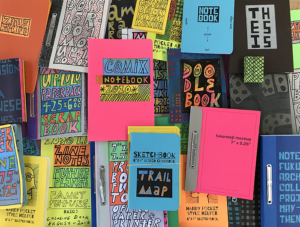 Timothy: As a novice artist, I once spent several months drawing pictures of lizards and turtles for researchers in an animal behavior lab. I loved being around all the gadgets and learning the jargon of science, but the most interesting aspect was watching everyone fill up stacks of green notebooks with scribbled facts, figures, and thumbnail sketches. This largely unseen work of scientific exploration revealed to me a vastly bigger and more complex process than I’d imagined before.
Timothy: As a novice artist, I once spent several months drawing pictures of lizards and turtles for researchers in an animal behavior lab. I loved being around all the gadgets and learning the jargon of science, but the most interesting aspect was watching everyone fill up stacks of green notebooks with scribbled facts, figures, and thumbnail sketches. This largely unseen work of scientific exploration revealed to me a vastly bigger and more complex process than I’d imagined before.
Since then, my education as an artist has taken a pinball’s path, rolling and rocketing from bumper to flipper and back again. Now in the afternoon of this journey, after trying on a dozen different identities, I tell people (and myself) that I make books about books. But, ever skeptical of neat categories and descriptions, I wonder every day what this actually means.
It helps reaffirm my practice to think back to all those amazing lab notebooks overflowing with blue, black, and red ink. Their rich beauty, not meant for the eyes of the lay public, made me interested in the stories behind stories. Of course, I also have the privilege of living with a writer, who has filled so many shapes and sizes of notebooks with ideas. A finished book on the shelf or a painting on the wall can be wonderful things, but to me the messy, freewheeling preparatory work that flows though notebooks and sketchbooks is every bit as fascinating. So, I make, or at least try to make, book-like objects that talk about the often overlooked labor of art.
Bryn: And I have the privilege of living with a visual artist whose sketchbooks burst with wild, beautiful drawings and annotations. Our artistic disciplines intersect in the realm of notebooks: writers, artists, and other creative thinkers, as Timothy mentions, find these compact paper spaces crucial for process and discovery. Time and again, I’ve scratched bits of imagery, scenes, and characters during long walks or early morning coffee; later in the same pages, I’ve refined and expanded those bits or ditched them altogether. I’ve pasted encouraging quotes, pictures, and notes to self. When I drafted Sycamore, I first highlighted and tabbed pages in the stack of notebooks I’d been working in. Some of those scraps made it in wholesale.
Living with an artist, I also know how valuable it is to make a notebook for a project. Book artists in particular build mockups for their projects, mapping and testing structures, and then filling the pages with calculations and notes, before embarking on the final piece. Why shouldn’t writers, too, make their own project-specific notebooks? These serve not only to capture our ideas but to remind us from the start that this work should have its own personalized, playful space that also is practical and portable. Anyone can buy a readymade journal, but slowing down and constructing one from scratch is a kind of promise: This work matters. It’s in my hands now.
ABOUT THE INSTRUCTORS:
About the Instructors: Bryn Chancellor is the author of the novel Sycamore, a Southwest Book of the Year and Amazon Editors’ Best Book of 2017, and the story collection When Are You Coming Home?, winner of the Prairie Schooner Book Prize, with work published in numerous literary journals. Honors include a 2018 North Carolina Arts Council Artist Fellowship and the Poets and Writers Maureen Egen Writers Exchange Award. She is associate professor at the University of North Carolina at Charlotte.
Timothy Winkler is an illustrator and book artist whose Modern Fauna Art & Ephemera Studio is currently based in Charlotte. A native of Nashville, Tennessee, he has long studied and worked in all the various media of printmaking. He earned his MFA in Book Arts at the University of Alabama and has taught letterpress printing at Penland School of Crafts and a course on Outsider Art at the University of North Carolina, Charlotte. Winkler was a 2020 recipient of an Arts and Science Council Artist Support Grant.
CREATE ZINES WITH BRYN & TIMOTHY: The road to a story winds through myriad notes and drafts. Join Bryn & Timothy on April 30, 2022 from 10 a.m. to 3 p.m. for Little Notebooks, Big Ideas: Zines for Creative Exploration. Making notebooks by hand lets writers immerse themselves in the critical early creative process and helps them commit to a project. We’ll make fun, easy, affordable, and portable notebooks in the spirit of zines, closer to Anne Lamott’s index cards than to fussy bound journals. We’ll start to fill the pages with targeted prompts for characters, settings, and scenes, and play with simple printmaking and collage to make them our own. Register Here
Note: This class includes an hour break for lunch. You can bring your own or visit one of several walking-distance options.
Finishing a Manuscript is Only the Beginning
 When I first began writing, I believed the most difficult part would be finishing a full-length manuscript, so I only thought it was important to take classes relating to story craft. It was a rude awakening to realize there was so much more I needed to know if anyone was ever going to be able to buy my book and read it.
When I first began writing, I believed the most difficult part would be finishing a full-length manuscript, so I only thought it was important to take classes relating to story craft. It was a rude awakening to realize there was so much more I needed to know if anyone was ever going to be able to buy my book and read it.
In a 2002 NY Times article, Think You Have a Book in You? Think Again, author Joseph Epstein cited a study that revealed “81% of Americans feel they have a book in them.” He goes on to use the rest of his essay to dissuade people from writing and suggests instead, “Keep it inside you where it belongs.”
Apparently, a lot of people do as Epstein suggests and “save the typing, save the trees.” On Reedsy.com, a blog states .01% ever make it to their goal of finishing that book. No doubt that is because a crafting great story is only about 30% of the book problem. Once authors type “The End,” it’s only the beginning of a long process to write query letters, secure an agent, sign a book contract and market the book. Add on to that the frustrating demand from publishers that writers must also build a “platform” on social media to sell their work, and really, it does seem like Epstein might have been right.
At the same time, it has never been easier for authors to bypass the agents who are gatekeepers of the Big Five publishing world and create their own books. The idea of “self-publishing” is not new, dating back to 1439 when the first printing press was invented by a German goldsmith named Johannes Gutenberg. Fast forward to 1979, when computers made desktop publishing accessible and the current print-on-demand technology possible.
In the last forty years, Amazon (KDP Direct) and Ingram (IngramSpark) have dominated and consolidated the POD world, creating a level of sophistication that can make a self-published book indistinguishable from traditionally published titles. But to navigate this part of the publishing universe, aspiring writers must learn how to turn their manuscripts into properly formatted files—a process which can seem daunting.
In truth, it simply takes more of the same persistence required to finish your 65,000-word manuscript. You can learn how to master plot lines and dialogue, as well as how to publish your own great book. Take, for example, the determination of Lisa Genova.
In 2007, she was simply a grad student who had received multiple rejections from traditional publishers. But Genova believed in her manuscript based on the story of her grandmother’s early onset Alzheimer’s, so the aspiring author self-published. After gaining popularity with readers, Simon & Shuster picked up the title and republished it two years later under the title Still Alice. Genova’s book, which had been initially rejected, was on The New York Times Best Seller List for more than 40 weeks, sold in 30 countries, translated into 20 languages, and became an Oscar-winning film. None of that would have happened if Genova had not taken the initiative to publish her own book.
In reality, writing a book is like completing a triathlon—and each of the three stages takes training: writing, publishing and marketing. Don’t wait until your last page to think about how to get your book in the world. Start now, learning to navigate the publishing and book-marketing world.
Maybe even more important than crafting your great characters is learning how your readers will ultimately discover them.
ABOUT KATHY: Kathy Izard is an award-winning author and speaker who helped bring transformation to Charlotte in homelessness, housing and mental health. Kathy self-published her first book, The Hundred Story Home, which received a Christopher Award for inspiring nonfiction and was acquired by Harper-Collins. Since 2016, Kathy has created her own imprint to publish three books for adults and children in print, e-book and audiobook. Kathy’s work has been featured on the Today Show and NPR inspiring people to be changemakers in their communities. Learn more www.kathyizard.com
“I’ve Always Wanted to Write a Book”
When I meet someone new, within the first few minutes, they inevitably ask, “So what do you do?” It’s an innocent question, but one that often leads to an interesting end: “I’m a writer,” I say, and many look wistfully into the distance and reply, “I’ve always wanted to write a book.”
A natural encourager, I invite them to share their ideas. I listen attentively, knowing that the first crucial step to writing a book is often a conversation like this. They try their best to sum up what’s been beating around their heads — sometimes for decades — and in so doing, realize they’ve never tried once to say it aloud. Then they give me the kind of smile reserved for fast friends — for the unexpected society found in the quiet corners of summer barbecues, football games and their tipsy on-lookers shouting in the background.
More than a decade into such conversations, more people than ever are lighting up as they tell me about their book ideas. Maybe it’s just that my friends and I are getting older, and questions of legacy and bucket lists and everything we’ve always wanted to do has become more urgent. Or maybe it’s the time we’ve all had in the last, languid years to dream up new worlds and characters and hobbies. Whatever it is, almost everyone has an idea now. Is it just a passing fad or something more profound: a recognition that the world needs longer, richer stories into which we can sink our teeth?
Sometimes these conversations lead to a practical question: How does one actually write a book? Nearly every time, the light that was so bright in their eyes begins to fade. I have to get up early? I won’t get paid for several years or maybe not at all? I have to convince a string of people, precipitously inaccessible, that my story matters? That sounds too much like work! We laugh and then transition to the next-best thing — a new Netflix series, the strange weather of late, the delicious dip Kelly brought — anything but the dream crashing down around us. We part ways with a tinge of regret.
But other times — and these are the ones I live for — the light of an idea grows brighter. As they ask about my discipline and practice, they begin to think they might want to do it, too. Faced with the long odds of publication and the cascades of rejection, there is a gauntlet thrown down at their feet. In that conversation, in that desire to make their ideas known to a wider world, they take the first, crucial step toward a goal they’ve had forever.
And it happens: they begin to write their book.
ABOUT MEG: Megan Rich has written two books, a YA novel and a travel memoir, and is seeking representation for her third, a literary thriller inspired by The Great Gatsby. She took part in the highly-selective sub-concentration in Creative Writing at the University of Michigan, for which she completed a thesis of original poetry. In addition, she’s a graduate of the Lighthouse Writers Workshop Book Project program. With fourteen years experience as a creative writing teacher and mentor of students from ages twelve to eighty-five, she is passionate about helping others find and refine their voices on the page.
JUMP START YOUR BOOK WITH MEG: Learn to create a lasting connection with your readers, by developing your voice in Meg’s upcoming class Novel Jumpstart, beginning Sunday April 3. In this four-week mostly-asynchronous studio we will help you decide if you want to write a novel, and if so, will help make the journey must less fraught. Through recorded lectures, readings, online discussions, and short assignments, we will examine the structures of stories, protagonists and their journeys, story worlds, story time, genre, point of view — and the habit, discipline, and support needed to get it done. More information here.
Note: Novel Jumpstart a great choice if you’re considering applying for Authors Lab, which begins in the fall.
Disrupting Process
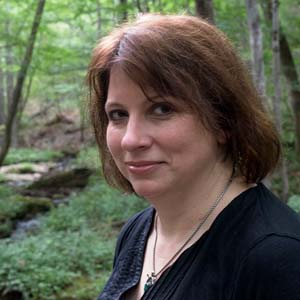 Process, the stages of creating—this is where a writer’s real power is. By being mindful of process and concentrating on the series of steps involved, rather than the final product itself, we end up where we want to be.
Process, the stages of creating—this is where a writer’s real power is. By being mindful of process and concentrating on the series of steps involved, rather than the final product itself, we end up where we want to be.
Process means giving yourself the chance to begin. It’s the best cure if you haven’t written in a while—to allow the half-formed, imperfect words to appear on the page. You don’t need the whole poem or chapter yet. You just need a snippet.
You have likely reflected on your own process. There’s not just one way. We writers love to ask each other such questions. It can become part of our identity: Are you a messy, illegible sticky-note writer? Or a loopy longhand on yellow legal pad writer? Whatever process you’ve developed, I am here to advocate the idea of disrupting it! Invite change. Make experimentation part of your process and see what happens.
Not long ago I started playing around with how I court new work by writing every day and by writing through prompts—strategies plenty of other writers do all the time. But not me, I never had. And I’d perhaps grown too accustomed to my process.
So instead of focusing so much on revision, which I dearly love, I started to focus intentionally on inception. I even started incorporating another form of artistic expression into my process—something I’m not good at, painting with watercolor. This was inspired directly by poet Gabrielle Calvocoressi. I also once heard fiction writer Barry Hannah give a talk along these lines—the value of letting yourself create in another form without trying to become good at it. Creating without a focus on mastery brought play and dreaming back to the forefront.
ABOUT JULIE: Julie Funderburk is author of the poetry collection The Door That Always Opensfrom LSU Press and a limited-edition chapbook from Unicorn Press. She is the recipient of fellowships from the North Carolina Arts Council and the Sewanee Writers’ Conference. Her work appears in 32 Poems, Cave Wall, The Cincinnati Review, Hayden’s Ferry Review, and Ploughshares. She is an Assistant Professor of Creative Writing at Queens University of Charlotte.
POETRY 101 WITH JULIE: Explore the world of verse by learning to read poems with the senses of a poet, and come away understanding what you missed in high school and college lit classes. Prose writers will gain a deeper appreciation of poetry and some inspiration—for ways to integrate poetic devices into their prose and to try out poetry for themselves. This class meets on-line via Zoom two Tuesdays, March 22 and 29, 2022, 6:00-8:00 p.m. In How to Read a Poem (and Maybe Write One) Julie will help budding poets to find their poetic vision and replenish their founts. More information here.

